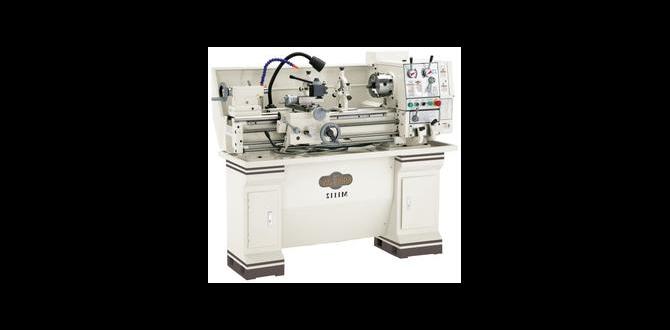A 1/8 inch carbide end mill is surprisingly effective for a clean, heat-resistant cut when machining nylon, making this versatile tool a great choice for hobbyists and makers working with plastics.
Cutting nylon with the right tool can feel like a magic trick. Sometimes it melts, sometimes it chips, and often it just makes a mess. Wouldn’t it be great if you could get clean, precise cuts on this popular material every single time? You can! Using a specific type of end mill, like a 1/8 inch carbide end mill, can transform your experience with nylon. We’ll explore why this small but mighty tool is perfect for the job and how to use it safely and effectively, so you can start creating with confidence.
Why a 1/8 Inch Carbide End Mill is Ideal for Cutting Nylon
Nylon is a fantastic material for many projects. It’s strong, durable, and relatively easy to work with. However, its melting point can be a bit tricky when cutting. If the tool is too slow, too dull, or generates too much friction, the nylon can start to melt. This gummy mess can clog your tooling, ruin your finish, and get frustrating fast. That’s where a properly chosen end mill comes in, and a 1/8 inch carbide end mill, especially one designed for plastics or with specific flute geometry, shines.
Understanding End Mills
Before we dive into nylon, let’s quickly talk about end mills. Think of them as specialized milling cutters. Unlike a drill bit that spins to make a hole, an end mill has cutting edges on the sides as well as the tip. This means they can cut sideways, plunge into material, and create slots, pockets, and profiles. They come in many sizes, materials, and flute configurations.
Carbide vs. High-Speed Steel (HSS)
For cutting plastics like nylon, carbide is often the preferred material for end mills. Here’s why:
- Heat Resistance: Carbide can withstand much higher temperatures than High-Speed Steel (HSS). When machining nylon, friction can generate heat. Good heat resistance prevents the cutting edge of the carbide end mill from softening and dulling quickly, and importantly, it helps prevent the nylon from melting.
- Hardness and Wear Resistance: Carbide is significantly harder than HSS. This means it stays sharp much longer, providing consistent cutting performance. For plastics, this means cleaner edges without melting or chipping.
- Rigidity: Carbide is more rigid, leading to less deflection. This is crucial for achieving precise dimensions, especially with smaller tools like a 1/8 inch end mill.
The “1/8 Inch” Advantage for Nylon
Why specifically 1/8 inch? Small diameter end mills have several advantages when cutting materials prone to melting:
- Reduced Cutting Forces: Smaller tools require less force to cut. Less force means less friction and less heat generation.
- Higher Spindle Speeds: Smaller end mills can often be run at higher spindle speeds (RPMs) on CNC machines. Higher speeds, when coupled with appropriate feed rates, can actually result in a cleaner cut for many plastics by shearing the material instead of rubbing it.
- Detail and Precision: A 1/8 inch end mill is perfect for intricate designs, small pockets, and fine details in your nylon projects.
Specialized Features for Nylon
When looking for a 1/8 inch carbide end mill for nylon, you might encounter terms like “plastic cutting,” “router bits,” or specific flute counts. Some end mills are designed with polished flutes or a high number of flutes (e.g., 3 or 4 flutes). While 2-flute end mills are common for general-purpose work in plastics, 3 or 4 flutes can provide a smoother finish if the feed rate is adjusted correctly to manage heat. For truly dedicated plastic cutting, some manufacturers offer specialized coatings or geometries that further reduce friction and chip buildup.
An “extra-long” shank can also be beneficial, allowing you to reach into deeper features or provide more clearance if your workholding is a concern, though always ensure you have sufficient rigidity for longer tools.
Essential Tools and Setup for Cutting Nylon
Before you start cutting, having the right setup is key for both safety and a good result. It’s not just about the end mill itself.
The Milling Machine
You’ll need a milling machine capable of holding and spinning your end mill at the right speeds. This could be a:
- CNC mill (desktop or industrial)
- Bridgeport-style manual mill
- Even a high-quality router with a suitable collet adapter for very light cuts.
The machine needs to be rigid and capable of accurate, consistent movement.
Collets and Tool Holders
A good quality collet system is crucial for holding an end mill accurately. A 1/8 inch shank requires a corresponding 1/8 inch collet. Ensure the collet is clean and the holder for the collet is also clean and free of debris. A runout (wobble) in your tool holding will lead to poor finishes and premature tool wear.
Workholding
Securely holding the nylon is paramount. Depending on the size and shape of your part, you might use:
- Vises: A standard milling vise with soft jaws (or precisely milled jaws) can hold flat stock.
- Clamps: Edge clamps or toe clamps for larger flat pieces.
- Fixtures: Custom-made fixtures for specific shapes or repetitive tasks.
- Double-Sided Tape: For very light cuts or small parts, strong double-sided tape might work, but is generally not recommended for anything substantial due to potential movement.
Always ensure your workholding won’t interfere with the cutting path of the end mill.
Safety Gear
Safety first, always! When milling, wear:
- Safety Glasses: Essential to protect your eyes from flying chips.
- Hearing Protection: Milling can be noisy.
- No Loose Clothing or Jewelry: These can get caught in moving machinery.
- Gloves: Use with caution. Sometimes gloves can reduce dexterity, but for handling parts or clearing chips, they can be useful. Just ensure they don’t interfere with your grip near moving parts.
Lubrication/Coolant (Optional but Recommended for Certain Nylons)
While many nylons can be cut dry with the right speeds and feeds, some benefit from lubrication or a light coolant. A blast of compressed air is often sufficient to clear chips and cool the cut. For more difficult-to-machine nylons or if you’re experiencing melting, a small amount of plastic-specific cutting fluid or even a mist coolant can help. Avoid excessive coolant, as it can sometimes act as an insulator and trap heat.
Step-by-Step Guide: Cutting Nylon with a 1/8 Inch Carbide End Mill
Let’s get down to business. Here’s how to make those clean nylon cuts.
Step 1: Prepare Your Nylon Stock
Ensure your piece of nylon is clean and free of dirt or debris. If it’s raw stock, check that it’s flat and square if your project requires it.
Step 2: Secure Your Workpiece
Mount the nylon firmly in your chosen workholding. Double-check that it cannot move during machining. A loose part is dangerous and will lead to poor results.
Step 3: Install the End Mill
Insert your 1/8 inch carbide end mill into a clean collet. Tighten the collet securely in the milling machine’s spindle. Ensure the end mill is inserted to a sufficient depth in the collet for rigidity – usually, at least half the flute length should be supported by the collet.
Step 4: Set Up Your Machine Parameters
This is critical for success. Here are general guidelines. Always test on scrap material first!
Spindle Speed (RPM): For a 1/8 inch carbide end mill cutting nylon, you’ll typically want higher spindle speeds. Start in the range of 10,000 – 20,000 RPM. The exact speed depends on the specific nylon type and the end mill’s design.
Feed Rate (IPM or mm/min): This is how fast the cutting tool moves through the material. A good starting point for 4-flute end mills might be around 15-30 Inches Per Minute (IPM) or roughly 380-760 mm/min. For 2-flute, you might feed slower, around 10-20 IPM (250-500 mm/min).
Chip Load: Chip load is the thickness of the material removed by each cutting edge per revolution. A common target chip load for plastics like nylon is between 0.001″ – 0.003″ per tooth. For a 1/8 inch end mill (0.125″ diameter):
- Chip Load = Feed Rate / (RPM Number of Flutes)
Example: For a 4-flute end mill at 15,000 RPM and 20 IPM, the chip load is 20 / (15000 4) = 0.00033″. This is a bit on the low side. You’d want to increase your feed rate for a better chip load. Let’s try a feed rate of 40 IPM: 40 / (15000 4) = 0.00067″. Still a bit low. Aiming for a chip load of 0.002″ per tooth:
- Target Feed Rate = Target Chip Load RPM Number of Flutes
- Target Feed Rate = 0.002″ 15000 RPM * 4 Flutes = 120 IPM.
This higher feed rate is often necessary to get a good chip and prevent melting. You’ll usually need to run your machine at its maximum speed and adjust the feed rate accordingly.
Depth of Cut (DOC): For an 1/8 inch end mill in nylon, take shallow depths of cut. A radial depth of cut (how much of the end mill’s diameter is engaged sideways) should generally be less than half the diameter, and a full slotting cut (axial depth of cut) of 0.100″ – 0.125″ (or less) is a good starting point. Steeper cuts generate more heat. Consider taking multiple passes at a shallower depth.
Step 5: Perform a Test Cut
If possible, always make a test cut on a scrap piece of the same nylon. This allows you to:
- Listen to the cut: Is it smooth, or is it chattering or making harsh noises?
- Observe the chips: Are they small, powdery chips, or are they melting and stringy?
- Check the finish: Is it clean and smooth, or is there evidence of melting or fuzziness?
Adjust your feed rate (usually increase) and/or depth of cut (usually decrease) based on your observations.
Step 6: Execute Your Machining Operation
Once you’re confident with your test cuts, proceed with your main operation. Start the spindle, then engage the feed. Use a smooth, consistent motion. For CNC, ensure your program is correct and run it through a simulation if available.
Step 7: Chip Evacuation
As the tool cuts, chips will be produced. For nylon, these can sometimes be wispy or fuse together. Use a brush or compressed air (carefully!) to clear chips from the cutting area as you go, especially if you’re not using flood coolant. Good chip evacuation is vital to prevent heat buildup and chip re-cutting, which causes melting.
Step 8: Finishing Passes
For a very fine finish, consider a final shallow “clean-up” pass at a slightly slower feed rate or a significantly shallower depth of cut. This can “scuff” up any slight fuzz left from the main cut.
Step 9: Clean Up
After machining, carefully remove your part. Clean the end mill and your machine of any nylon debris.
Key Considerations for Different Nylon Types
Not all nylons are created equal. The type of nylon you’re using will significantly impact your machining parameters. Referencing manufacturer data sheets for specific nylons can be very helpful.
Nylon 6 (PA6) vs. Nylon 6/6 (PA66)
Nylon 6 and Nylon 6/6 are common. Nylon 6 generally has a slightly lower melting point than Nylon 6/6, meaning it might be more prone to melting during machining. Both are generally machinable with carbide end mills, but the parameters might need fine-tuning.
Filled Nylons
“Filled” nylons contain additives like glass fibers, carbon fibers, or minerals to enhance properties like strength, stiffness, or wear resistance. These can be ABRASIVE.
- Tool Wear: Filled nylons will wear down standard end mills much faster. Carbide is essential, and you might consider specialized hardened carbide tools or even ceramic or PCD tooling for high-volume production or very abrasive grades.
- Chip Formation: Be aware that glass fibers, for instance, don’t melt. They will break up into particles. This means you might get a powdered debris rather than chips to worry about re-fusing.
- Parameters: You might be able to use slightly higher feed rates due to the filled material’s stiffness, but always monitor for tool wear.
Nylon Properties and Machining Behavior
Here’s a quick look at how some properties influence machining:
| Property | Impact on Machining | Mitigation Strategy |
|---|---|---|
| Melting Point | Prone to melting with excessive heat/friction. | Use sharp carbide tools, higher spindle speeds, adequate feed rates, shallow DOC, and good chip evacuation. |
| Toughness | Can create long, stringy chips that fuse. | Ensure good chip load to shear material cleanly; use air blast or mist coolant if needed. |
| Moisture Absorption | Can soften and swell; affects dimensional stability. | Machine dry if possible or use coolant sparingly. Allow parts to stabilize dimensionally before critical measurements. |
| Abrasiveness (Filled Grades) | Rapid tool wear. | Use harder carbide grades, coated tools, or specialized tooling; expect shorter tool life. |
Tips for Achieving a “Genius” Nylon Cut
What separates a good cut from a “genius” cut? Attention to detail and understanding the material.
- Sharpness is King: Always use a sharp, high-quality carbide end mill. A dull tool is the fastest way to melt nylon.
- Listen to Your Machine: Your ears are great diagnostic tools. Chattering, squealing, or rubbing sounds indicate something is wrong – usually feed rate, depth of cut, or dull tooling.
- Feed Rate Over Speed (Sometimes): While high RPMs are good for clearing material quickly, the feed rate is often more critical for preventing melting. If you’re melting, try increasing your feed rate (if your machine can handle it) or decreasing your depth of cut.
- Manage Heat: Heat is the enemy of clean nylon cuts. Implement strategies to dissipate it:
- Compressed air blast.
- Mist coolant.
- Shallow depths of cut.
- High spindle speeds with appropriate feed rates to promote shearing.
- Don’t Plunge Aggressively: While some end mills are designed for plunging, it’s generally best to avoid plunging straight down into nylon with a standard end mill. Instead, use a helical (spiral) interpolation to enter the material, or engage from the side.
- Experiment with Flutes: While 2-flute end mills are common for plastics, don’t rule out 3 or 4-flute. With the right feed rate (you’ll need a higher IPM for more flutes to maintain chip load), they can offer a smoother finish.
- Consider End Mill Coatings: While not always necessary for simple nylon jobs, coatings like TiAlN or ZrN can offer additional heat resistance and lubricity, extending tool life and improving finish.
Common Machining Challenges with Nylon and How to Solve Them
Even with the best tools, you might run into a few snags. Here’s how to troubleshoot:
Challenge: Melting Nylon
- Cause: Too much friction, too slow a feed rate, dull tool, or excessive depth of cut.
- Solution: Increase spindle speed, increase feed rate, decrease depth of cut, ensure tool








